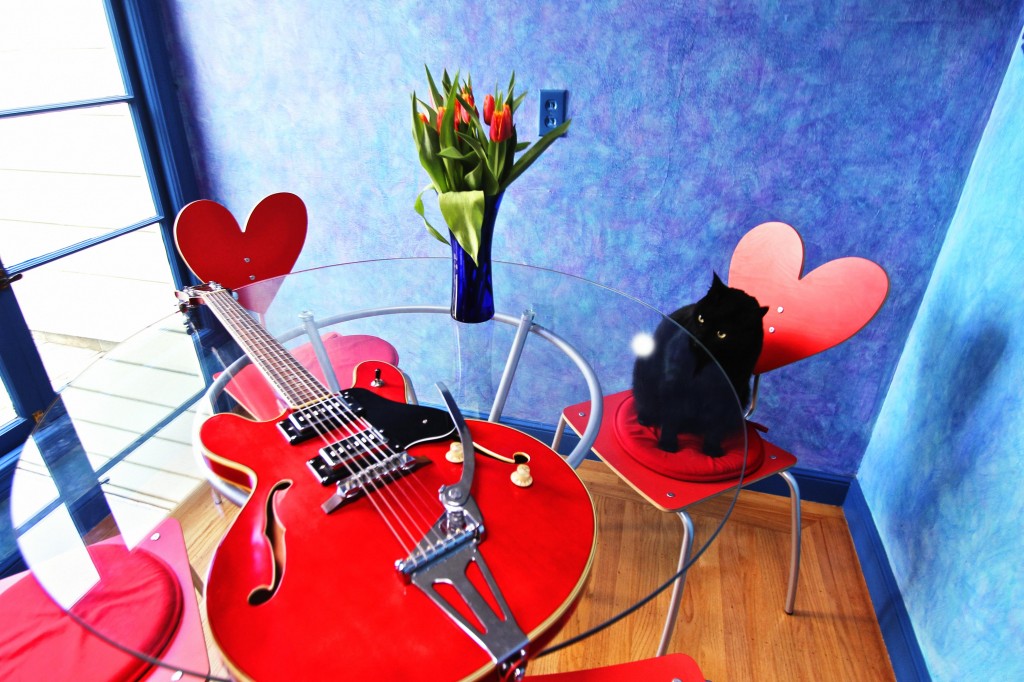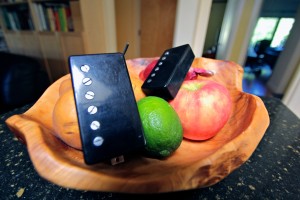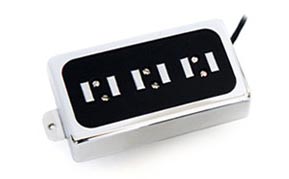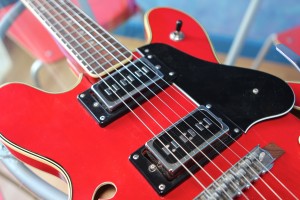Multiple readers have asked some variation of that question since I launched this blog last month. I’ve been wondering myself as I prowled the local music emporia, searching for a fun, but seriously funky guitar to experiment on.
Veteran pickup-swappers are aware of what I call the “Squier Syndrome”: Some budget Asian guitars are remarkably playable, but come stocked with low-performance pickups. Replacing the pickups can deliver a huge sonic upgrade. If you find the right cheapie at the right price, you can create an instrument that rivals a U.S.-made model from a major manufacturer at something like half the cost. In fact, I’ve got a fine example in my studio right now, which I’ll write about soon.
But that is not today’s subject.
Nope, I wanted something weird and wild, a real “character” instrument. So when I spotted this egregious ES-335 knockoff at my local cool guitar store, I snatched it for $300, case included. (Everything’s expensive in San Francisco—chances are you can find the equivalent for less in your neck of the woods.) It was made in Japan by Tempo some decades ago. (Online info is sketchy because, well, no one really cares.) It’s pretty, it’s in great condition, but let’s face it: It’s a cheap-ass piece of molded plywood with a tentatively bolted-on neck and some seriously microphonic pickups, which I wrote about here. Here’s what they sounded like:
Unbelievably Microphonic PickupWhy buy this thing? Because it feels comfy, and since it’s a hollowbody, it has lots of odd little acoustic possibilities, like strumming behind the nut and bridge. It practically plays in tune, so long as you don’t confront the fake Bigsby tailpiece with anything more than a mild wiggle.
Plus, I “needed” a cheap guitar for jingle work. As anyone who’s worked in that field recently will confirm, just about the only stuff anyone buys these days are tracks that sound homespun and “indie,” preferably with a slightly out-of-tune, amateurish feel. The Tempo’s time has come!
Before installing swapping out the pickups and doing a basic setup, I tracked a few clips using the guitar in its original state:
Original Tempo Neck Pickup Original Tempo Bridge PickupNot exactly tones for the ages, are they?
Next question: What to install instead?
Easy! A gorgeous pair of Seymour Duncan Custom Shop Phat Staple pickups. I’d never tried staple-style pickups. I’m not sure I’d even heard them! Created for Gibson in 1954 by Seth Lover, these single-coil pickups use individual Alnico 5 pole piece magnets, as opposed to the bar magnets of Gibson’s earlier P-90. But the model was lost in the shuffle of history thanks to the introduction of the P.A.F. humbucker the following year. I’d heard the sound described as a slightly twangier P-90, as you’d expect given the individual pole pieces. The SD version has been reformatted to fit a humbucker-sized rout, but like the original, there are honking-big screw mechanisms on the underside of the device, barring its installation in some guitars. But they fit the Tempo perfectly.
Changing pickups in a hollowbody can be a challenge for the clumsy and inexperienced (AKA “me”). A real guitar tech probably would have replaced all the pots and wires, but I took the lazy way out and simply snipped the wires close to the pickups and grafted the new pickups to the old wiring with solder and heat-shrink tubing. Worked fine!
Here’s how the Tempo sounded post-surgery:
Tempo Guitar with Staple Neck Pickup Tempo Guitar with Staple Bridge PickupOkay, before drawing too many conclusions about staple pickups, remember that I’ve installed them in a truly funky instrument—the results would be quite different with a less laughable specimen of luthiery. But even so, the changes are dramatic. I hear higher highs, lower lows, clearer fundamentals, and less of the ugly, nasal resonance that marked the originals.
Yep, they do indeed sound a bit like twangier P-90s, and yes, they are a bit noisy. (There’s a reason, after all, that the humbucker was such a hit!) The tone reminds me a bit of the Dearmond/Dynasonic pickup I wrote about here, though it’s hard to make direct comparisons based on my audio clips, since I put the latter pickup in a high-quality archtop with flatwound strings.
But enough analysis—let’s hear the noise! Everything here except the bass and drums was recorded using the Tempo guitar with Phat Staple pickups and a buttload of plug-ins in Logic Pro.
Tempo Track Rough MixWell, for better or worse, my tawdry dreams came true. I’m definitely going to whip out this instrument the next time an artist or client wants something a little less slick-sounding!
Buoyed by enthusiasm, I slapped some guitars on a track from an album-in-progress by my pal, producer and Violent Femmes drummer Victor DeLorenzo. How cool is Victor? Cool enough to let me post this exceedingly rough mix, featuring my Tempo guitar tracks slapped onto a two-track rough mix featuring his drums, voice, and bass synth. (That’s a rough mix on top of a rough mix, which makes it exponentially rough!)
Carry Me (VERY Rough Mix)And in case you’re curious, here’s a bounce featuring only the guitars. There are percolating, afrobeat-inspired lines played through stingy little filters, lots of spacy, behind-the-tailpiece plucking routed through delays and pitch-shifts, and an obnoxiously loud, realtime-backwards solo.
Carry Me (ugly guitars only)Sounds trashy. Sounds amateurish. Sounds out of tune. That makes it a triple-crown winner!
Okay, show-and-tell time: Let’s hear YOUR trashy guitar tales. Preferably with pics and audio!












Oh man….where to begin….
Kramer striker 300: Plywood guitar + Dimarzio X2n and two Choppers = shred city!
Kaman GTX 36 (Black Beauty Copy): $150 + DiMarzio Tone Zone (soon to be Duncan JB
Rather pretty but sonically boring Epiphone LP Classic: Mysterwood + Duncan Pearly Gates/Custom Custom
Dean Cadillac Select: $299 Ebay Korean win + Duncan Pearly Gates/Custom
I can’t even remember them all. Man – pawn shops were awesome back before ebay…
I always think the key to el cheapo but functional guitars is to add pickups with personality, as opposed to great PAF’s.
Yeah, I’m ion the process of doing some nasty things to an Aria Pro II I snagged for $200. Probably the closest thing I’ll ever get to making a shred guitar.
Aceman I had a Kramer Striker 100. it felt ok but sounded bland.
Then I put a JB into it and WOW what a difference.
It souled me on Seymour Duncan Pickups ad my tone was saved.
I got some beat up Silvertone “rock – it” SG knock off on Craigslist a while ago and stuck in some Gibson ’69 SG reissue humbuckers in it. It’s an awesome little guitar for 100 bucks, but when I whip out a real SG and play them side by side on just about anything, there is always an annoying tinny, more thin tonality about it that becomes evident regardless of the genre. While pickups can definitely improve a guitar’s sound, a quality guitar can’t be beaten.
I totally agree — but like I hinted in the post, there are times where an “quality” sound just isn’t the most appropriate tone for a particular musical context. I like comparing it to acting. Sometimes you don’t want to be “pretty” or “handsome”— the role might call for something grotesque or ugly.
A pair of MJ wound custom shop Greenie humbuckers installed in an Epi Les Paul custom made this axe channel Billy G. simply amazing. $300.00 used guitar + $300.00 worth of pickups = $1000.00 worth of tone.
What a value !
Got a Yamaha pacifica 112 strat copy (HSS). Unknown body wood with a swimming pool pickup rout, maple neck, rosewood fretboard. Its got a Dimarzio Air Norton humbucker in the bridge, a Seymour Duncan Alnico II pro single coil in the middle position and a Lace sensor gold in the neck. I also upgraded the tremolo with a GFS brass tremolo (it made a huge difference IMO) and a nice setup.
Sure, it´s got limitiations, because the build quality isnt the best It aint no PRS, but it stays in tune and sound wise it´s very very VERY close to american strats I have A/B it with. Perhaps just a little bit thinner sounding,in a good way. So with $250 I got a guitar that can hang with the bigboys!
In my experience, Pacificas are exceedingly well made, with way-better-than-average fretwork in particular. It doesn’t surprise me in the least that you could turn that into a killer instrument.
Yamaha did make a lot really good sounding, almost there, just needs a little tweaks, instruments in the mid to late 90’s. My guitar in particular was purchased back in 1998. I bought it cheap from a friend who had it laying around in his closet. The single coils that came with it were actually that bad … But the SD is just so much better. Great blog by the way! Love the “use your ears instead of you eyes (and wallet) to determine if something sounds good” perspective.
Thanks!
Yamaha’s Pacifica line was the brainchild of my pal Rich Lasner, a brilliant designer who’s done stuff for Ibanez, Korg, Peavey, Yamaha, and others. Great player, great designer, great guy.
I’ve done a lot of experimentation with this, every guitar i’ve owned or build has have different pickups, or stock pickups swapped almost straight away, a matter of principle for me rather than preference, as i’ve found it is where the manufacturers will skimp first (unless if what you’ve bought is a custom shop, or something specific). it is kind of like asking a soprano opera singer to sing through a voicebox. you need to give the guitar a voice!
after building more than a few guitars now, the specifics about wood tonality and type of paint used and hardware’s so called effect on the overall electric guitar’s tone in negliable to me – nothing dictates the output more that the electrics, yet people go on and on about how their basswood guitar sounds awesome, or their maple neck sounds brighter etc, while others hate basswood or maple, for example.
Wood selection would definitely influence an acoustic guitar – but with solid body electrics – i really doubt it. I’ve gotten into many a discussion about this with fellow luthiers and there are very different schools of thought on this!
my point is that if you got say, 10 guitars of the same design, same strings, same hardware, same pickups and electrics, same cables and same amp, set and intoned them all the same, the theory is, of course, consistancy in how they would all sound. In the real world, this scenario doesn’t exist – all of these above factors that influence tone are all completely different, and in so many combinations of being different – and i haven’t even touched on how well the person ‘hearing’ the output changes things too.
to me, there is 3 guitar designs – acoustic, semi-hollow and solid, each with their own sound characteristics, regardless of design. you change a pickup and it will definitely change they way it sounds – and that’s why I love guitar – no two guitars will sound the same. it is totally down to personal preference and what sounds great to you.. when you close your eyes and really listen.
end rant 😀
As “rants” go, that was rather refined! 😉
The whole alchemy of guitar tone is sort of . . . well, just that. Alchemy, in the sense of an arcane body of knowledge that seems about half grounded in science, and half in mystical wishful thinking.
Sounds like the basis for a very illuminating blind-listening test… 🙂
A $360 Michael Kelly Patriot Custom “2nd” with a tiny finish blem on Ebay with SD Antiquities installed sounds SICK. I own a Gibson LPPR9 59 Reissue LP and this Patriot has better sustain and fewer dead spots on the fretboard. Also good CTS pots and Hovland MusiCap capacitors are the way to go with the new Antiquities. If you want Jimmy Page circa 1970s LP tone – SD Antiquities are a good economical approach to get it.
Yeah, the Antiquity PAFs are phenomenal. 🙂
I’m curious — can you actually hear any sound difference from the caps? I have NEVER been able to discern any difference based on cap type in a passive guitar circuit. (I’m not talking cap value, mind you — that makes a major difference, as detailed here:
https://www.tonefiend.com/guitar/customize-your-caps/
But switching between, say, modern film caps and retro-style “audiophile” ones? I want to hear the evidence!
I always tell people
Crappy Guitar + Awesome Amp = Pretty Good
Awesome Guitar + Crappy Amp = Crap
That can be further broken down….
Crappy guitar with Awesome pups = Pretty decent
Awesome Guitar with meh pickups = Feels good, sounds meh.
So Crappy Guitar + awesome Pickups + Awesome Amp = Almost Awesome
Not to be contrarian, but some of the best stuff I’ve ever recorded was done on crappy amps!
Now, there’s crappy and there’s crappy. The bad crappy is anything boring and lifeless. Good crappy is anything quirky and interesting.
Example: I’ve done some great stuff with those toy Marshall practice amps. A fave example is “Working for the Man,” from PJ Harvey’s To Bring You My Love album. Another amp horror is the godforsaken Baldwin Professonal:
https://www.tonefiend.com/wp-content/uploads/Unknown.jpeg
This thing is a nightmare. Low power. Ugly, edgy, overly resonant tones. Five pushbutton presets of spectacular ugliness. And the thickest, nastiest, cheapest spring reverb I’ve ever heard. It rules!
You can hear it on the Tracy Chapman song “Another Sun”:
https://itunes.apple.com/us/album/let-it-rain/id293102735
Tracy played the bass and the pretty electric guitar on the predominates on the right channel. The reverb-sodden atmospherics on the left channel are me playing the Baldwin.
I love this horrid reverb so much that I made an impulse response of it. if you own the Altiverb reverb plug-in, you can download this sound, plus some other crappy spring reverbs, for free here:
https://www.audioease.com/IR/VenuePages/reverbgear.html#crapreverb
That’s math even I can understand, Aceman!
Whew…cool and/or crappy guitars…been through a few, but the one I really miss (why did I sell it?) is a ’60s Egmond electric, a semi-hollow (but looks solid), black-Leatherette covered faux Jazzmaster. The pickups were pretty much dook- the polepieces didn’t even come close to matching the string spacing, despite everything about the guitar being proprietary. Made in Denmark, if I recall correctly. Did I mention the awesome mother of toiletseat pickguard, matching (!!!) MOP headstock overlay, and aluminum binding?
The pickups were kinda meh, the electronics questionable, and the neck was okay, but not the greatest. The bridge was as basic as basic can be, and not permanently attached, but as a whole, it was light, comfy, sounded reasonably good, and looked cooler than any other guitar I’ve ever owned. Also had the bestest vibrato tailpiece ever- looked and functioned similarly to a Jazzmaster/Jag wang bar, but instead of the sliding tremolo lock, you could adjust it with a screwdriver, from totally stationary to stable but very, very waggable.
Now that I think about that Egmond, I may hafta track another one down, change the pickups and install a Mastery bridge on it…
I have not double blind tested the musicaps against stock caps which would be the real way to test it… I swap the Antiquity PAF pickups pots and caps in sets and it always turns out so well i have not tested the old caps. In DYI speaker crossovers we have clearly heard the improvement of the the Hoviland caps. In an LPR9 the Antiquity PAFs are amazing. They transformed an ok guitar into a very very nice LP. In a Heritage H-150, with Antiquity PAFs, an EL-34 Bogner Shiva and a 30 watt green back cab I get the tone I have heard in my head for 30 years. And with the tone knob rolled back that H-150 sounds perfectly like an ES-175! With Ebay prices Antiquity PAFs are one of the great pickup values of all time. (Others have their faves too so rock on with whatever pickups that bring joy to your playing. peace!)
Joe I can’t listen to the last 3 clips which are m4ps. So if you want convert them to mp3s :D.
Your wish is my command! 🙂
Try again.
Take an Agile Guitar, replace the electronics and you have a guitar that Rivals just about anything Gibson sells today.
One thing I’d like to add to this. Pots, switches, jacks and wiring are usually subpar when the pickups are subpar. when I swap out pickups on a lower cost guitar, I almost always swap out the entire electronics kit. It never ceases to amaze me when I open up a guitar and find ‘mini-pots” They come out every time!
And now that pretty much any guitar with frets that have sufficient material can be fine tuned on a Pleck machine these nice imported guitars can be made to play much better than the big retail brands.
https://www.plek.com/en_US/home/
Man those Agile instruments look sweet! Cool Korean copies are fun to check out. There is a Hannes bridge from Schaller we want to try out before NAMM and an Agile guitar may be the perfect platform for a test. https://guitar-bridge.com/hp135009/Guitar.htm
Also that Michael Kelly Patriot technically is not crappy… just economical at $360. It is resonant as hec and with Antiquity PAFs through that Shiva sounds like a $3200 long tenon LPR9 ’59 Reissue (with fewer dead spots on the fretboard too)
I hadn’t even heard of Agile guitars. I’d love to get my hands on one — they certainly LOOK nice.
Here in San Francisco, I take all my guitars to the brilliant Gary Brawer:
https://brawer.com/
…who was one of the earliest users of the Plek system, and who now has two of them in his shop. It’s amazing to watch one of those machines do its thing.
I haven’t reviewed tons of guitars side-by-side since I worked at Guitar Player back in the ’90s. But even then, some of the better Asian production-line guitars would arrive with better setups and superior fretwork relative to leading US-made guitars — even expensive custom shop models. There are DEFINITELY a lot of recession-friendly alternatives out there…
At user group day Seymour was rocking a used Schecter. Pretty midline in the g=big scheme of things. But throw Seymour’s chops and a pair of Duncan Antiquities in the mix through a classy Fender….BAM.
Seymour is SOOOOOO good. It’s in his hands. 🙂
Yeah – but the antiquities didn’t hurt….
Maison LP replaced with SD 59′ on the neck and JB on the bridge. Although the original ones weren’t that horrible with the SD’s it became another guitar. The pickups costed almost the same as the guitar in the 90’s but it was totally worth. Just listen
https://youtu.be/0FYVtOTHOno
https://youtu.be/g_Oc0owacOk
The demos are horribly played and recorded but you can get the idea. Believe me it sounded much better in a real amplifier.
I have a bit of a penchant for Switch guitars which are one piece made of a polyurethane resin foam material that sounds like a dark mahogany. I have three of the Les Paul like models which sustain even longer than Robert Fripp’s old Black Beauty Les Paul. They come with ok humbuckers sort of like potted PAFs but they were a too dark even for me. I replaced the humbuckers on two of them with SD Phat Kat P90s which really did the trick for me. Ialso installed Gibson TP6 stop tail piece fine tuners (which actually increased sustain). They now have plenty of high end and work well for my mainly slide style one has flat wounds and the other round wounds. The Phat Kat P90s are great pickups that have the P90 tone but due to the metal cover have considerably less noise pickup problems. The Switch guitars are a bit heavy for me with my bad back but worth a little pain as the sustain is amazing, playing Fripp like lines is almost second nature to them. In fact they sustain so much that I don’t really like using an Ebow on them (and I love my Ebows). I also have Roland GK3s on them and they trigger very well even with my old GR30. The third one is sort of a semi-Les Paul Jr with string thru body and an odd bridge it has Guitar Fetish Mean P90s and is a scrappier sounding guitar with the same sustain characteristics.
I don’t know about changing pickups.
I used to do it a lot, thirty years ago, in the early days of Duncan and DiMarzio. But now I see that it didn’t improve my music, or get me more gigs. (Of course, if you have reliability or noise issues, change ’em.)
To me, your Tempo guitar sounded fine before you changed the pickups. You play with a lot of truth and soul, and that comes across far stronger than any sonic difference. (I admit that everything above 4 kHz is pretty much history for me, though.)
Kinda analogous to breast implants in a way, dontcha think? Why mess with natural, with original?
Hi giza! And thanks for the kind words about my playing.
Well, the good news for aging electric guitarists is that the instrument doesn’t even HAVE many frequencies over 4 kHz. 😉
I don’t buy your boob job analogy, however. With any guitar, someone, somewhere made a decision about which pickup to include. All too often, that choice is strictly a matter of saving a few bucks. Using crap pickups pickups is one of the most frequently cut corners. Plus, even if a guitar was created with quality pickups, we as players may have musical needs that the builder never anticipated. It’s about customizing your tools to best realize your music. If you guitar does so as is, well, all is good. 🙂
This is around the fifth time I stumbled on one of your articles and was bummed the sound samples weren’t there.
Still an entertaining read though!
Thank you!
[…] key metric when navigating the dense market of guitar accessories. This ability to blend *quality and cost-effectiveness* makes them a formidable player in the realm of […]